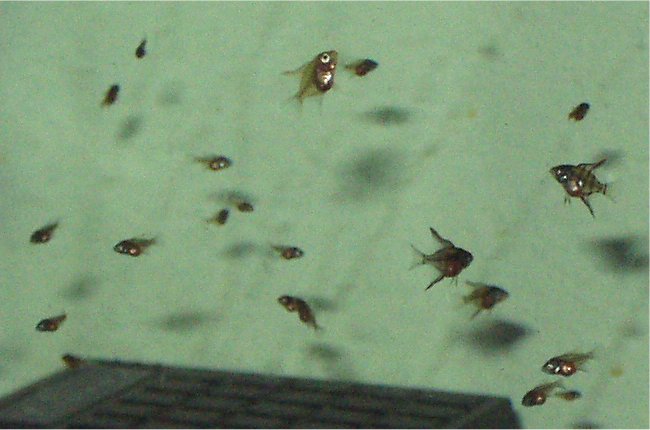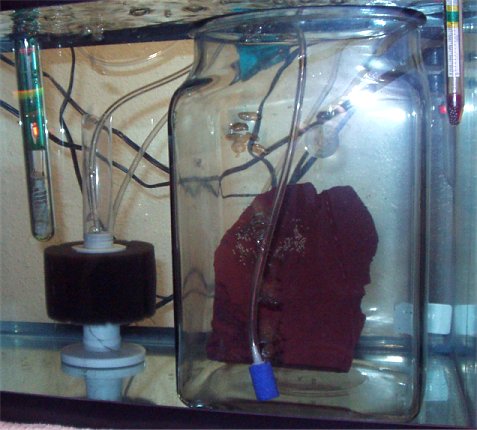Breeding Angels
To begin with, I'll let you know that there is tons of info out there about breeding angels. I wont repeat what is in the books, instead I'll tell you what has worked for us.
- Water quality. All of our fish live in water that has a pH of 7.0-7.4 and a temp of 80 degrees F.
- Sexing your fish
- Angels are difficult to sex until they have paired off and begun to spawn.
- When they are ready to spawn you will notice a tube protruding between the feeler fins and the anal fin (real close to where they poop from). The female's tube will be short and cone shaped. The male's will be thinner and longer.
- Angels will not spawn until they are approx. 1 year old.
- To start, buy 6 or 7 juvenile angels. Most likely you will get at least 2 pair out of 6 or 7 fish. You can get all the same breed or a mixture, they will interbreed. Albinos are hardest to breed, so its best for beginners to stay away from albinos.
- At approx. 1 year of age, they will begin to pair off. When they do, they will often spar with the other angels. This sparring can get violent at times so you should have a tank set up and ready for your pair.
- It is normal for a pair to spar with each other. As long as they don't seem too violent and aren't injuring each other, this is nothing to worry about.
- Setting up your breeding tank
- I recommend a 29 gallon tank for breeding. If space is a serious consideration, a 10 gallon tank will suffice.
- Leave the bottom of the tank bare.
- Put a piece of slate against the side of the tank at a fairly sharp angle.
- A sponge filter is essential in a breeding tank
- An airstone near the slate is helpful but not essential.
- Spawning will occur usually, but not always, immediately after a 40%-50% water change.
- The female will begin by laying eggs in columns on the slate. The male will follow, fertilizing in columns.
- When you notice eggs on the slate add a dose of methelyne blue (3/4 teaspoon per 10 gal.) This will prevent most of the eggs from getting fungus.
- The parents will take turns continuously fanning the eggs with their fins until they hatch.
- Do NOT do any water changes from now until the babies are free swimming.
- 60-72 hours from now the eggs will begin to hatch. You will notice that the eggs are wiggling. This is the tails emerging from the eggs.
- The parents may now begin moving the eggs from the slate to the sponge filter. Don't freak out, it looks like they are eating the fry, but they are just moving them.
- In another 60-72 hours the fry will be free swimming.
- You should be able to leave the fry with the parents for at least a week or two (see notes at bottom of page).
- Raising the fry
- You might have 200-300 fry. I recommend at least a 45 gallon grow out tank for this many babies.
- Feed live baby brine shrimp or microworms.
- Do a 50% water change EVERY day. It WILL make a difference in the quality of your fish (healthier, and taller fins).
- After about 4 weeks you can start feeding flakes.
- By 12 weeks you should either sell them or at least thin out the tank.
- If you are not successful the first time, don't fret, you'll get another chance. With regular water changes, they should spawn again within 10 days to 2 weeks.
NOTES
Angels are usually excellent parents. They will usually spend all of their time taking care of their fry, even becoming aggressive if you come near their tank when fry are present. On rare occasions they will end up eating the fry sometime during the process. If this happens more than once you should consider artificial hatching. If this happens you have a couple of options.
- Move the parents to another tank after the eggs have been fertilized.
OR
- Put a 1 gallon pickle jar in the tank and slide the slate into the jar. Make sure you have an airstone in the jar with the eggs. I use a 2 gallon wide mouth jar, but they are harder to find.
- Add methelyne blue.
- Do daily water changes in the jar until the eggs hatch.
- After 2 days move the entire jar into an empty 10 gallon tank.
- After the fry have been free swimming for a couple of days, remove the jar and the slate. When the fry are big enough to make it crowded, move them to a grow out tank.

eggs on the slate. Notice the tubes protruding from the parents. The male is closest to the slate.

Fry at approx 5 weeks.

artificial hatch





